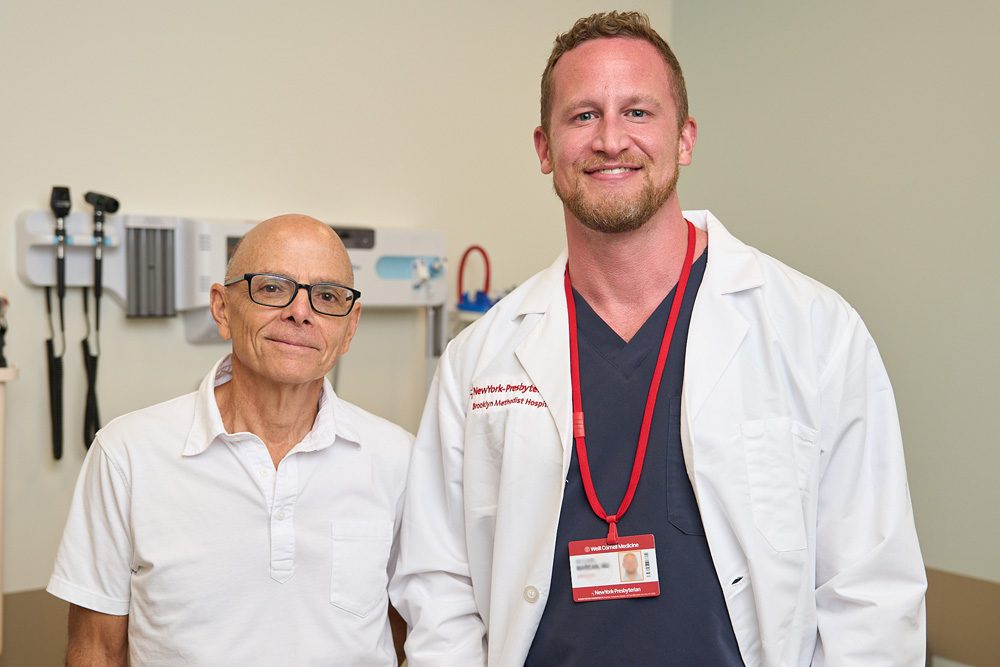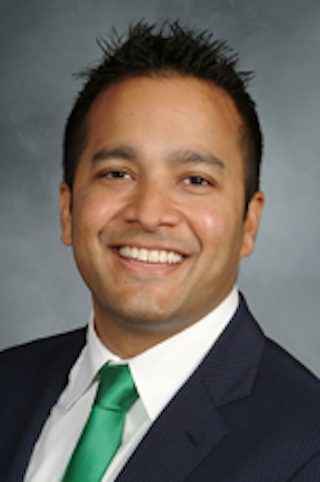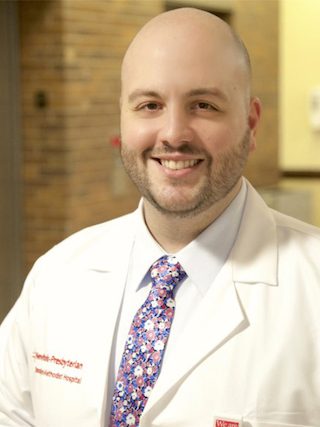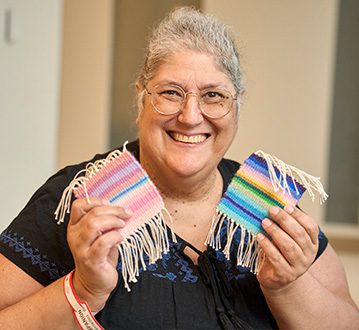Sharing Healing Through Weaving
After a prostate cancer diagnosis, textile artist José Picayo found calm in hand-weaving — inspiring him to start a weaving class for fellow patients and build a community of healing.
On a recent summer afternoon, textile artist José Picayo guides a group of students, many of whom are also cancer patients, through a hand-weaving class as they pull colorful strings of yarn over and under their small wooden looms.
“That looks like an ocean,” Picayo says to one student, Linda, whose loom is nearly completed with rows of yarn in vibrant shades of blue. “That’s what I was going for,” Linda says, smiling.
Every two weeks, Picayo, 63, transforms a lounge area near an infusion unit at NewYork-Presbyterian Brooklyn Methodist Hospital’s Center for Community Health into a classroom for patients and hospital employees. Round tables are stacked with brightly colored yarn, tapestry needles, and plastic forks, which the students use to push the yarn down and tighten the rows on their 5 by 5-inch looms.
“The goal is to give people something to forget about their worries, because that’s what it does for me,” says Picayo, who was diagnosed with prostate cancer at the end of 2022 and has been getting his care at NewYork-Presbyterian Brooklyn Methodist Hospital. “When I’m weaving, I really don’t think about anything else.”
Students pause from their pieces to admire each other’s work, joke around with one another, and share stories. “Since I came, my anxiety has gone away,” says Kim, whose yellow earrings match the yarn on the piece she’s making for her boyfriend. “When there is so much going on, this feels like taking myself to a spa – a form of self-care.”
A longtime photographer, Picayo has found solace in weaving since he discovered the art form in 2014 at a weaving class at the Textile Arts Center in Brooklyn. “You start with one thread, and you make these incredible pieces,” he says.

José Picayo with his urologist, Dr. Michael Marean. Picayo and his care team opted for active surveillance of his prostate cancer.
Choosing an “Active” Approach to His Cancer
In September 2022, during a routine visit to his general physician, Picayo learned his prostate-specific antigen (PSA, or the protein produced by tissue in the prostate, a small gland that sits below the bladder in men) levels were unusually high. He went to see Dr. Michael Marean, a urologist at NewYork-Presbyterian Medical Group Brooklyn, for further testing. A biopsy revealed a small amount of cancer cells. Because the cancer is expected to grow slowly, Picayo and his care team, which includes Dr. Peter Gregos, a hematologist oncologist at NewYork-Presbyterian Medical Group Brooklyn, decided to take the approach of observation, often referred to as watchful waiting or active surveillance. This means his care team will actively monitor his cancer through regular blood tests, exams, biopsies, and imaging tests when necessary, rather than with aggressive treatment.

Dr. Zachary Mulvihill
In addition to the regular visits and screenings, Picayo also meets with Dr. Zachary Mulvihill, a physician at Integrative Health and Wellbeing at NewYork-Presbyterian, in collaboration with Weill Cornell Medicine. “One of the guiding principles of integrative medicine is that we treat the whole patient, not just their separate medical conditions,” says Dr. Mulvihill, who recommended Picayo consider adding acupuncture and meditation to his regimen and make a few diet adjustments. “This allows us to make a more holistic treatment plan for the patient’s overall health and well-being.”
The Gift of Weaving
Weaving has remained a comfort for Picayo through his prostate cancer diagnosis — and he’s paid it forward in his classes. Picayo got the idea to teach the class during a consultation appointment with Dr. Himanshu Nagar, a radiation oncologist at NewYork-Presbyterian/Weill Cornell Medical Center. He saw a flyer in the office about painting classes for patients and hospital employees.

Dr. Himanshu Nagar
“I said to my wife, ‘I’m going to ask about it, because I want to teach weaving,’” says Picayo. Even before his diagnosis, Picayo had wanted to bring the gift of weaving to patients in a hospital. “I’d started to read about the benefits of fiber arts in dealing with illness and taking people’s minds away from all that,” he says. The flyer motivated him to act. “I thought, ‘If I’m not going to do it now, I’m not going to do it.’”
He inquired at the front desk, and was put in touch with Kaitlyn Shechtman, director of the oncology service line at NewYork-Presbyterian Brooklyn Methodist Hospital, and Deanna Saab, a program coordinator on Shechtman’s team. Shechtman had organized an oncology art therapy program at the hospital, which included the painting class Picayo saw advertised, and didn’t hesitate when she heard from Picayo. “Let’s make it happen,” Shechtman recalls telling him. “He was inspired to give back, and that inspires us.”

Dr. Peter Gregos
His hematologist oncologist, Dr. Gregos, was touched when several of his patients, unaware of his connection to Picayo, mentioned they had discovered the class and were enjoying it.
Shechtman and Saab worked with Picayo to arrange for supplies, the room, and spreading the word to patients and employees. The class kicked off in March.
“I like seeing patients get their minds off things,” says Saab, who coordinates the class and has been at work on her own piece. “José brings a warm energy that makes everyone comfortable.”
“I love the vibe,” agrees Leana Laraque, a program coordinator at Weill Cornell Medicine who works with blood cancer patients at NewYork-Presbyterian Brooklyn Methodist Hospital. Laraque stopped by the class one day to speak with a patient who had a question about a clinical trial, and now visits the class when her schedule permits. “It’s a welcoming and relaxing space, and it’s great to see patients enjoy this.”
Picayo takes pride in the students and their work, and the sense of community the classes are bringing. He’s especially pleased to see students keep returning. “To hear them say that for two hours, they didn’t think about anything other than weaving, is really the most incredible, rewarding part of the class for me.”
“I’m so happy to hear that the class gives people a respite from what they are facing,” says Dr. Gregos, who is also an assistant professor of clinical medicine at Weill Cornell Medicine. “A lot of people can have feelings, like they become their diagnosis, and their life is revolving around their condition and treatment. To be able to shift the focus to something creative, I believe can lead to healing and a change in mood and help them on their journey.”
Adds Dr. Mulvihill: “It is powerful when a group of patients come together in a community of mutual kindness and support.”
In Their Own Words: How Hand-Weaving Brings Comfort

Linda Avitabile
I’ve been coming to NewYork-Presbyterian Brooklyn Methodist Hospital for breast cancer treatment. They have been managing my whole cancer care — doctors and staff have just been warm and wonderful. In the front office, a social worker told me there were arts and crafts classes, including hand-weaving. I was interested in trying it, but at first was feeling too sick to go.
When I began to feel more energetic in May, I joined my first class. It has been great to have something to do that is relaxing and keeps my mind occupied; and José is very welcoming. He shares his work with us and talks about different styles and the history of hand-weaving — it is like a 16th-century looming workshop that is carried into the present. To start, I worked with yarns resembling beach-setting colors, blue (my favorite color) for the ocean, tan for the sand, and green for the trees. It was fun putting the colors together. I have also worked on one with different shades of pink.
Since my diagnosis in August 2022, it has been a whirlwind. My entire life was taken over by cancer — I was either having an operation, seeing doctors, going to chemotherapy, or recovering from it. But having something like hand-weaving helped me emotionally and made me feel less stressed. It was something normal, and it was nice to do something that was fun and had nothing to do with cancer.
— Linda Avitabile

Kim Best
This morning, I was feeling anxious but coming to the class has helped. When I got here, the energy was good energy. The anxiety started to calm and now it’s totally gone.
The class is a place that creates peace for me. It’s like a still moment, sitting in a setting with a group dynamic of like-minded folks who are interested in creating something so beautiful. I’m happy here because I love colors, and weaving is very therapeutic.
The class takes away all the stressors of the day and whatever you’re feeling, including pain because I am in a lot of pain every day. It just takes my mind off wondering and wandering. I don’t think about anything when I’m weaving. I’m just focusing on my piece, making sure it is neatly done. It’s an excellent thing.
José is phenomenal as a teacher. He’s very patient and teaches us to get it right. He doesn’t make you feel uncomfortable about getting it perfect, he’ll see where you make your mistake and help you fix it. José will share stories, and we’ll share stories, so we’re creating this bond within the group. We’re chuckling, giddy; we’re relaxing, smiling, and creating. José is just an amazing being. I’m grateful for his presence, his artistry, and his masterpieces. Thank you, José, for being here and instructing us on this wonderful therapeutic art. — Kim Best

Gregory Gnoza
I learned about two classes – the art and hand-weaving classes – when I went in for radiation. A receptionist had pointed it out to me. I thought I would take a chance and give the classes a shot and I ended up liking them. I started the hand-weaving classes in March of this year. I had no clue about how to do hand-weaving before, so to me it was a new challenge.
I have prostate cancer — I was diagnosed with stage four on November 2, 2022. I have radiation therapy and hormone infusions. The doctors say I will be getting them for about three more years. The classes help me try something new and make me look forward to going to the hospital. They help me have something planned for the week.
I also enjoy being with people, sitting down with them, and talking face to face. I talk with the participants, receptionists, security officers. I look forward to going to the classes each time. I’m not good about doing my homework and taking the hand-weaving loom home, but when I’m at the classes, I enjoy it and like to pick multiple colors for the hand-weaving.
The bright colors make me feel happy. — Gregory Gnoza
Additional Resources
Learn more about cancer care at NewYork-Presbyterian.

